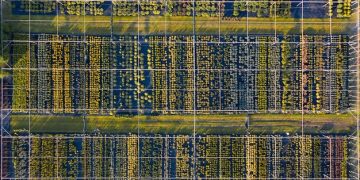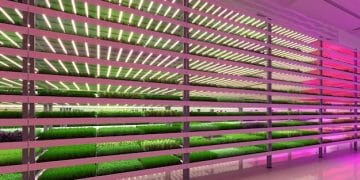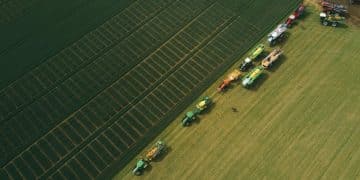Choosing the Right Agricultural Software for Your US Farm in 2025
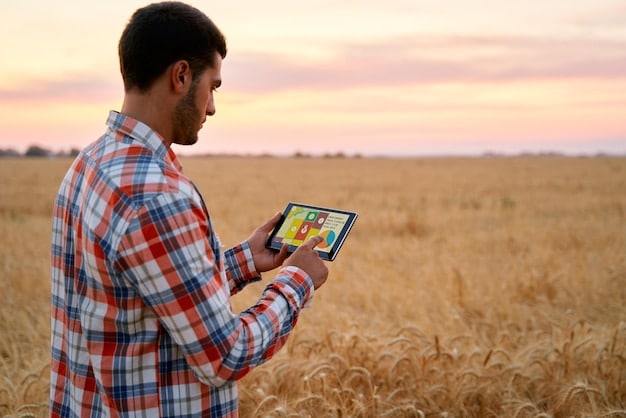
Choosing the right agricultural software for your US farm in 2025 involves a comprehensive comparison of features, compatibility, cost, and support, ensuring that the chosen solution aligns with your specific farming needs and contributes to increased efficiency and profitability.
Selecting the appropriate agricultural software is crucial for the success of any US farm in 2025. With technological advancements rapidly transforming the agricultural landscape, understanding your options is more critical than ever. This article offers a comprehensive comparison to guide you in how to choose the right agricultural software for your US farm in 2025.
Understanding the Evolving Needs of US Farms in 2025
The agricultural sector is undergoing a significant transformation, driven by technological innovations and changing consumer demands. Farm managers need to adapt to these trends and leverage the latest tools to remain competitive. Understanding the evolving needs of US farms is the first step in selecting the right software.
The Role of Technology in Modern Farming
Technology plays a pivotal role in enhancing efficiency, productivity, and sustainability in modern farming. From precision agriculture to data analytics, the right tools can make a significant difference. This section will dive into some of the areas where technology is essential for farming.
- Precision Agriculture: Using sensors, GPS, and other technologies helps optimize planting, irrigation, and fertilization processes.
- Data Analytics: Analyzing farm data to track yields, predict trends, and make informed decisions.
- Automation: Automating tasks such as planting, harvesting, and livestock management to reduce labor costs and increase efficiency.
The demands on farms are constantly increasing, and staying ahead requires integrating technology effectively.
Key Challenges Faced by US Farms
Despite the advancements in technology, US farms still face several challenges that require innovative solutions. These obstacles often impact profitability and sustainability. Some of these key challenges include:
- Labor Shortages: Finding and retaining skilled labor is a growing concern for many farms.
- Rising Input Costs: The cost of seeds, fertilizers, and other inputs continues to rise, squeezing profit margins.
- Environmental Regulations: Compliance with environmental regulations adds complexity and expense to farm operations.
These challenges can be mitigated by implementing appropriate technological solutions that address these pain points directly.
As US farms increasingly rely on technology, choosing the right agricultural software becomes a pivotal decision. By understanding the changing landscape and the challenges ahead, farmers can make informed choices that optimize their operations and ensure long-term success.
Identifying Your Farm’s Specific Needs and Goals
Before diving into the array of software options available, it’s essential to pinpoint your farm’s specific needs and goals. A thorough assessment will illuminate the areas where software can provide the most significant impact. Consider your farm size, type of crops or livestock, current processes, and long-term objectives.

Conducting a Needs Assessment
A comprehensive needs assessment involves evaluating every aspect of your farm operation. Identify bottlenecks, inefficiencies, and areas where improvements can be made. Consider both short-term and long-term goals. This analysis will serve as a roadmap for selecting software that aligns with your unique requirements.
- Evaluate Current Processes: Review how tasks are currently performed and identify areas for improvement.
- Identify Pain Points: Determine the biggest challenges impacting your farm’s productivity and profitability.
- Set Measurable Goals: Define specific, measurable, achievable, relevant, and time-bound (SMART) goals.
Without a clear understanding of your needs, it’s easy to invest in software that doesn’t deliver the expected benefits.
Aligning Software with Your Farm’s Objectives
Once you’ve identified your needs, align your software selection with your farm’s overall objectives. Consider how the software will contribute to achieving your goals, whether it’s increasing yields, reducing costs, or improving sustainability. Select software that offers the features and functionality needed to support your strategic priorities.
This alignment ensures that the investment in agricultural software yields tangible results and contributes to the farm’s long-term success.
By thoroughly assessing your farm’s needs and aligning software solutions with your objectives, you can make informed decisions that drive efficiency, productivity, and profitability.
Exploring the Different Types of Agricultural Software
The agricultural software market offers a wide range of solutions designed to address various aspects of farm management. Understanding the different types of software available is crucial for choosing tools that meet your specific requirements. Each type offers unique functionalities tailored to enhance efficiency and productivity.
Farm Management Software (FMS)
Farm Management Software (FMS) provides a comprehensive platform for managing all aspects of farm operations. From planning and budgeting to tracking inventory and managing labor, FMS offers a centralized solution for streamlining workflows and making informed decisions. This type of software is essential for a holistic view of operations and for streamlining overall management.
By integrating data from various sources, FMS enables farmers to gain valuable insights into their operations and optimize resource allocation.
Precision Agriculture Software
Precision Agriculture Software utilizes advanced technologies such as GPS, sensors, and data analytics to optimize planting, irrigation, and fertilization processes. This type of software enables farmers to apply resources precisely where they are needed, reducing waste and maximizing yields. Precise data leads to better management and resource utilization.
- GPS Guidance Systems: Enables precise planting and harvesting.
- Sensor-Based Monitoring: Monitors soil conditions, weather patterns, and crop health.
- Variable Rate Application: Adjusts fertilizer and irrigation rates based on real-time data.
Data-driven decisions are at the heart of precision agriculture, leading to more sustainable and efficient farming practices.
Accounting and Financial Management Software
Accounting and Financial Management Software helps farmers manage their finances, track expenses, and generate financial reports. This type of software is critical for maintaining accurate records, complying with tax regulations, and making informed financial decisions. Proper financial management is the backbone of any successful farm.
By automating financial tasks, this software reduces the administrative burden and frees up time for farmers to focus on other aspects of their operations.
Navigating the diverse landscape of agricultural software requires a clear understanding of the different types available. By evaluating your farm’s specific needs and selecting the right software, you can optimize operations, reduce costs, and improve overall profitability.
Key Features to Look for in Agricultural Software
When evaluating agricultural software options, it’s important to focus on the key features that align with your farm’s specific needs. These features should enhance efficiency, improve decision-making, and contribute to overall profitability. This section will examine some of these key feature areas.
Data Integration and Compatibility
Seamless data integration is crucial for harnessing the full potential of agricultural software. Ensure that the software can integrate with existing systems and data sources, such as sensors, weather stations, and accounting software. Compatibility ensures easy data flow and reduces errors.
- API Integrations: Ability to connect with other software platforms.
- Data Import/Export: Easily transfer data between systems.
- Real-Time Data Sync: Automatically update data across all devices.
Without seamless data integration, you may find that the software creates more work than it saves.
User-Friendly Interface and Mobile Accessibility
A user-friendly interface is essential for maximizing adoption and minimizing training time. The software should be intuitive and easy to navigate, even for users with limited technical expertise. Mobile accessibility allows you to access critical information and manage tasks from anywhere on the farm. Ease of use and accessibility are paramount.
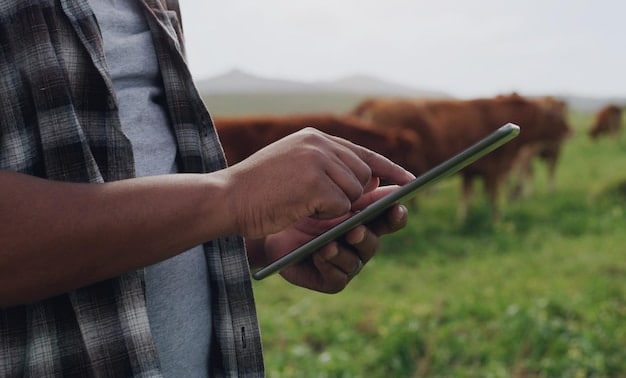
This ensures that farmers can stay connected and informed, even when they are away from their desks.
Reporting and Analytics Capabilities
Robust reporting and analytics capabilities provide valuable insights into farm operations, enabling you to make informed decisions and optimize resource allocation. Look for software that offers customizable reports, data visualization tools, and predictive analytics. Understanding data is at the core of making informed decisions that drive productivity.
These capabilities help you identify trends, track performance, and make adjustments to improve overall efficiency.
Selecting agricultural software with the right features is critical for achieving your farm’s goals. By focusing on data integration, user-friendliness, and reporting capabilities, you can invest in a solution that delivers measurable results.
Comparing Top Agricultural Software Options for 2025
The market for agricultural software is expansive, with numerous options vying for attention. To make an informed decision, it’s crucial to compare the leading software providers and their offerings. This comparison should consider features, pricing, customer support, and overall value. Farmers need a clear understanding of what’s out there and how each option aligns with specific needs.
AgriWebb
AgriWebb is a comprehensive farm management software designed for livestock producers. It offers features such as livestock tracking, grazing management, and compliance reporting. AgriWebb is known for its user-friendly interface and robust mobile capabilities. For livestock focused farms, AgriWebb might be an ideal choice.
Its focus on livestock management sets it apart from more general-purpose FMS solutions.
Granular
Granular is a farm management software that focuses on crop production. It offers features such as field planning, budgeting, and performance analysis. Granular is particularly well-suited for large-scale farming operations. It’s a data heavy platform that provides extensive data insights for management and optimization.
- Field Planning: Plan crop rotations and input applications.
- Budgeting: Create and manage budgets for each field.
- Performance Analysis: Track yields and profitability.
Considered by many to be a leader in agricultural technology, Granular provides a multitude of tools that can help reduce cost and increase ROI.
Climate FieldView
Climate FieldView is a precision agriculture platform that provides insights into weather patterns, soil conditions, and crop health. It offers features such as yield monitoring, variable rate application, and predictive analytics. This tool focuses heavily on optimizing the yield of crops.
FieldView is designed to help farmers make data-driven decisions that improve yields and reduce input costs.
By carefully comparing these and other agricultural software options, you can identify the solution that best aligns with your farm’s specific needs and budget. Remember to consider the long-term value and potential ROI of each software option.
Implementing and Maintaining Your Agricultural Software
Selecting the right agricultural software is only the first step. Proper implementation and ongoing maintenance are essential for maximizing its benefits and ensuring long-term success. Careful planning and execution are critical for smooth transitions and continuous improvement. This section will offer guidance on implementing and maintaining your agricultural software.
Planning for Implementation
Before deploying your chosen software, develop a detailed implementation plan. This plan should outline the steps involved, the timeline, and the resources required. Consider training needs, data migration strategies, and integration with existing systems. Careful planning will minimize disruptions and ensure a smooth transition.
- Define Objectives: Clearly define what you want to achieve with the software.
- Set a Timeline: Establish a realistic timeline for implementation.
- Assign Responsibilities: Assign specific tasks to team members.
Without a solid plan, implementation can quickly become chaotic and lead to frustration.
Providing Training and Support
Adequate training and support are essential for ensuring that your team can effectively use the software. Provide comprehensive training sessions, user manuals, and ongoing support resources. Consider offering customized training tailored to different roles and skill levels. Ongoing support is vital for addressing issues and maximizing the software’s potential. Training is essential for making sure the tools are being used as efficiently as possible.
This helps to maximize the software’s value and minimizes the learning curve.
Regular Maintenance and Updates
Regular maintenance and updates are critical for keeping your agricultural software running smoothly and securely. Stay up-to-date with the latest software releases, security patches, and feature enhancements. Perform routine maintenance tasks, such as data backups, system checks, and performance monitoring. Addressing problems as soon as possible keeps everything running smoothly and securely.
These updates ensure that your software remains reliable and protected against potential threats.
Implementing and maintaining agricultural software requires careful planning, training, and ongoing support. By following these guidelines, you can ensure that your software delivers maximum value and contributes to the success of your farm.
| Key Point | Brief Description |
|---|---|
| 🎯 Identify Farm Needs | Assess your farm’s specific requirements before selecting software. |
| 📊 Evaluate Software Types | Understand the different types of ag software (FMS, precision, etc.). |
| 📱 User-Friendly Interface | Choose software with an easy-to-use interface and mobile access. |
| ⚙️ Implementation Plan | Develop a detailed implementation plan and ensure user training. |
Frequently Asked Questions (FAQs)
▼
Agricultural software helps US farms in 2025 by optimizing processes, reducing costs, increasing yields, and improving overall efficiency. It enables data-driven decisions that are essential for remaining competitive in the modern agricultural landscape.
▼
To choose the right software, identify farm-specific needs, evaluate different types of software, compare key features, and consider factors such as pricing, customer support, and ease of use. Also aligning the overall goals of your farms with the tools available.
▼
The different types of agricultural software include Farm Management Software (FMS), Precision Agriculture Software, Accounting and Financial Management Software, and specialized software for specific crops or livestock. Each offers unique functionalities.
▼
Data integration is crucial as it ensures seamless data flow between different systems, such as sensors, weather stations, and accounting software. It reduces errors, improves efficiency, and provides a holistic view of farm operations.
▼
Mobile accessibility allows farmers to access critical information and manage tasks from anywhere on the farm. This ensures that they can stay connected, informed, and responsive, even when they are away from their desks. The ease of access and mobility makes mobile a crucial tool.
Conclusion
In conclusion, how to choose the right agricultural software for your US farm in 2025 requires a comprehensive approach that encompasses needs assessment, software comparison, and a well-thought-out implementation plan. By understanding the evolving needs of the agricultural sector and leveraging the latest technology, farmers can optimize their operations, improve profitability, and ensure long-term success.
